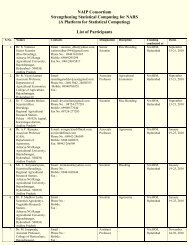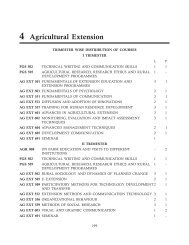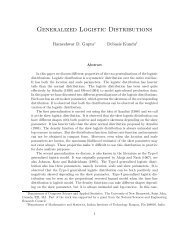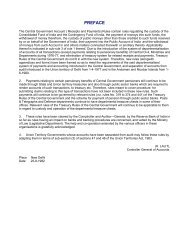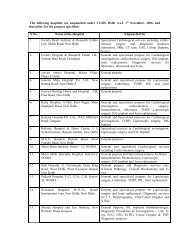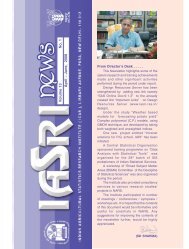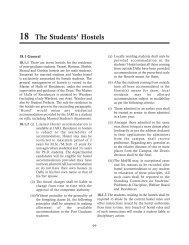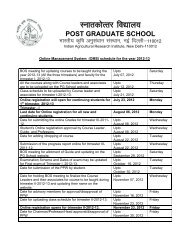abstracts - IASRI
abstracts - IASRI
abstracts - IASRI
You also want an ePaper? Increase the reach of your titles
YUMPU automatically turns print PDFs into web optimized ePapers that Google loves.
Theme 3: Agricultural Informatics<br />
T3.1I<br />
Pansy: A Portable Autonomous Irrigation System<br />
Benjamin Beckmann and Ajay Gupta<br />
Wireless Sensor Network (WiSe) Laboratory, Department of Computer Science,<br />
Western Michigan University, Kalamazoo, Michigan, USA<br />
Temperature, humidity, chemical composition and soil moisture are some of the factors that<br />
need to be carefully monitored to insure the longevity and health of the crop. Over thousands<br />
of year’s humans, farmers have learned that this monitoring needs to be done frequently and<br />
is labor intensive, time consuming and expensive when many crops are simultaneously being<br />
grown. We introduce a design of a preliminary system using wireless networked sensors,<br />
which makes monitoring and irrigating the crop efficient and reduces, if not, eliminates<br />
human interaction with the crop during its growth period.<br />
Intelligent wireless sensors can be deployed in a greenhouse environment and effectively<br />
monitor the environment and irrigate crops when needed for varying durations. This<br />
automated irrigation is ideal for a greenhouse application since slight changes in the climate<br />
within the greenhouse can cause irreversible damage to sensitive crops. By introducing smart<br />
wireless sensors into a greenhouse environment the growth of the plants can be controlled<br />
dynamically with very little human intervention. The intelligent wireless sensors produce an<br />
environment where every plant in the greenhouse can be monitored at a rate hundreds of time<br />
higher than a grower could possibly do alone.<br />
The system introduced in our work uses a minimal amount of environmental factors to<br />
monitor and sustain crops. It reduces human contact, water and chemical usage, and labor<br />
costs, while producing crops with solid root structures, healthy foliage, and high bloom<br />
counts. Once the wireless sensor devices are in place they self-organize and dynamically<br />
control the local climate according the crop species. Positive side effects of such a system are<br />
highly accurate inventories, species location, and elimination of barcodes on pots.<br />
We will present the design of architecture for a portable autonomous irrigation system,<br />
named PANSY, using intelligent wireless sensor devices. Experimental results are discussed,<br />
which show PANSY’s potential and current ability to produce crops equivalent to those<br />
produced by a professional grower. We also describe how it can be deployed in a greenhouse<br />
to achieve this goal. Deployment of PANSY-like systems is also beneficial in other situations<br />
where water is scarce or chemical fertilizers need be carefully controlled.<br />
T3.2I<br />
Hierarchical Censored Production Rules (HCPRs) System – A Frame Work for<br />
Intelligent Systems<br />
K.K. Bharadwaj<br />
School of Computer & Systems Sciences, Jawaharlal Nehru University, New Delhi
In the real world, both humans and computers often have to reason using insufficient,<br />
incomplete, or tentative premises. Moreover both are subject to constraints of time and<br />
memory. Variable Precision Logic (VPL) (Michalski and Winston, MIT, 1986) is concerned<br />
with problem of reasoning with incomplete information, subject to resource constraints and<br />
the problem of reasoning efficiently with exceptions. VPL offers mechanism for handling<br />
trade-off between the precision of inferences and computational efficiency of deriving them.<br />
Specificity and certainty are the two aspects of precision. Certainty refers to the degree of<br />
belief in a statement, whereas specificity refers to the degree of detail of a description.<br />
As an extension of standard Production rule, Michalski and Winston proposed the Censored<br />
Production Rule (CPR) of the form:<br />
IF THEN UNLESS,<br />
as an underlying representation and computational mechanism to enable logic based systems<br />
to exhibit variable precision in which certainty varies while specificity stays constant. To<br />
address various problems and shortcomings with CPRs system, Bharadwaj & Jain (1992)<br />
introduced a concept of Hierarchical Censored Production Rule (HCPR) of the form:<br />
Decision IF <br />
UNLESS <br />
GENERALITY <br />
SPECIFICITY ,<br />
which can be made to exhibit variable precision in the reasoning such that both certainty of<br />
belief in a conclusion and its specificity may be controlled by the reasoning process. Several<br />
extensions/generalizations of the system have been proposed and recently efforts are being<br />
made towards knowledge discovery and knowledge management - automated<br />
discovery/management of knowledge in the form of HCPRs (see the references). The HCPRbased<br />
system would be able to adjust the certainty/specificity of inferences to conform to<br />
time constraints. Such a system has numerous applications in situations where decisions must<br />
me made in real time and with uncertain information-examples range from medical expert<br />
systems for operating rooms to domestic robots.<br />
T3.3I<br />
Digital Networks for Farmers: A Step towards Faster and More Inclusive Growth in<br />
Rural India during 2007 – 2012<br />
Madaswamy Moni<br />
National Informatics Centre, New Delhi<br />
There have been concerns about persistent rural poverty, unemployment and inequality, and<br />
resulting social tensions at grassroots level in India. The strategies and policies developed by<br />
the Planners and Policymakers, adopted two approaches: one focusing on the overall<br />
economic development (through percolation, trickle down and spread effect), and the other<br />
poverty alleviation (direct intervention). Though these two approaches reinforce each other,<br />
there has been no effect to integrate them. At the beginning of the new millennium, 260<br />
million people in the country did not have incomes to access a consumption basket, which
defines the poverty line. Of these, 75 per cent were in the rural areas. Agricultural wage<br />
earners, small and marginal farmers, casual workers engaged in non-agricultural activities,<br />
rural women (especially women-headed households), among the others, constitute the bulk of<br />
the rural poor. The growing populations need food, clothing, shelter, fuel and fodder for their<br />
livestock.<br />
As market oriented economic development proceeds, Indian farmers in rural areas continue<br />
to experience great disparity in income compared with other sectors. They revert to natural<br />
resources as the most accessible sources of livelihood. Degradation of natural resource is a<br />
key threat to socio-economic development, and to global environment (e.g., climate change<br />
and loss of biodiversity). After decades of limited success in eliminating rural poverty, new<br />
ideas about rural development (i.e. viable society in a rural space, livelihood approach,<br />
sustainable livelihood approach, sustainable agricultural and rural livelihood approach,<br />
sustainable community concept, Multiple Livelihood Opportunities, etc) are emerging so as<br />
to reduce the vulnerability of the rural poor. Poverty Alleviation, Livelihood Opportunities<br />
and Gainful Employment are closely linked.<br />
Science & Technology offers tremendous opportunities in simultaneous achievements the<br />
goal of sustainable agriculture and improving rural livelihoods. “Doubly Green Revolution”<br />
adheres to “growth in agricultural production” and “improved livelihoods” now. Digital<br />
opportunities have emerged as “power tool” for fostering agricultural growth, poverty<br />
reduction and sustainable resources use in developing countries. Rural India requires to be<br />
given a chance through DNF for moving towards “faster and more inclusive growth”<br />
during the 11 th plan period, i.e. 2007-12.This paper deals with the Indian Government<br />
initiatives and progress on digital networks for farmer (DNF) and digital inclusion for<br />
fostering rural prosperity and reducing spatial disparities in India.<br />
T3.4I<br />
Information Kiosks in Rural India:<br />
An Opportunity for Agricultural Research to Reach the Un-reached<br />
V.P. Sharma and K.V. Rao<br />
National Institute of Agricultural Extension Management (MANAGE), Hyderabad<br />
ICTs have started to make their presence felt in Rural India. The farmers and farm-families<br />
are browsing the net and getting general, technical and marketing information from the<br />
Information kiosks in over 26000 villages across the country. If the rural India can be<br />
connected and the “masses” are empowered with “Information”, the Indian Economy will<br />
take a leap forward into the Digital Millenium with a great speed. The process has already<br />
started. The focus on “e-Governance” and “IT for Masses” is also emerging as front runner in<br />
all these State vision documents. Technologies specially suitable for Rural Areas are being<br />
developed and deployed.Portals on Rural Markets and Agricultural Services are being<br />
hosted. District level Web Sites are being hosted, Information Kiosks are being established at<br />
block/ Mandal and village levels and the technical and other need-based information is being<br />
collected, digitized and hosted on the Internet. Private Sector has taken lead in providing<br />
comprehensive “Extension” and “Marketing” content services to the Farmers. The “echaupals”<br />
of ITC and “Agriwatch.com” web-portal are the trend-setter scaled-up across the<br />
country.
The ICTs are thus supplementing the efforts of Agricultural Extension system (both in public<br />
sector as well as in private sector) to become a more dynamic instrument of continuous 2-way<br />
dialogue with the Farmers, on various issues. There are broadly 4 types of ICT enabled<br />
interventions for improving rural communication system, with focus on delivery of<br />
Agricultural Information, in India. These are:<br />
‣ National Government initiated Projects;<br />
‣ State Government promoted Projects;<br />
‣ Private Corporate Sector promoted Projects; and<br />
‣ Non-Government Sector (not-for Profit) sector promoted projects.<br />
The authors (along with his team two support Faculty members) have undertaken a research<br />
study on assessing the “Imapact of Information Kiosks on Farmers”, during June – September<br />
2005. In depth study was undertaken for 60 Information Kiosks in three states of the country,<br />
besides personally interviewing 270 farmers. The paper discusses in brief the basic<br />
objectives, funding pattern, outreach, content (quality, timeliness and completeness),<br />
community orientation of the projects, capacity building, linkages with other public and<br />
privte institutions for information support and sustainability issues.<br />
T3.5I<br />
Assembling the Maize Genome on Large-Scale Parallel Computers<br />
Srinivas Alluru<br />
Bioinformatics and Computational Biology Program, Iowa State University USA<br />
Maize genome is currently being sequenced by a consortium of Washington University,<br />
University of Arizona, Iowa State University, and Cold Spring Harbor Laboratories. Repeats<br />
span 65-80% of the maize genome, which creates particular challenges in its sequencing and<br />
assembly. In this talk, I will describe parallel bioinformatics methods we developed for this<br />
purpose, especially for assembling sequences resulting from gene-enrichment sequencing<br />
strategies. I will present our assembly efforts on the IBM BlueGene/ L massively parallel<br />
supercomputer, and discuss current progress on the NSF/USDA/DOE interagency project for<br />
maize genome sequencing.<br />
T3.6I<br />
Rural Knowledge Centers as Facilitators of New Learning Opportunities for the<br />
Rural Families: a case study<br />
Dileep Kumar Guntuku 1 , Sreenath Dixit 2 and Balaji Venkataraman 3<br />
1<br />
Department of ICT for Agriculture, DA-IICT, Gandhi Nagar<br />
2 Division of Resource Management, CRIDA, Hyderabad<br />
3 Knowledge Management and Sharing Group, ICRISAT<br />
There are various names and descriptions for rural knowledge centers, but their main role is<br />
facilitate the access to managed or direct information services for rural families. India is<br />
home to a very large number of pilot projects in this sector over the last about ten years. The<br />
number of internet-connected rural knowledge centers varies but is believed to be close to<br />
10000 as of mid-2006. The recent decision of the Government of India to establish about<br />
1,00,000 Common Service Centers has generated altogether new possibilities and
opportunities to design and make available a wide range of information services for the rural<br />
poor in India.<br />
Earlier studies indicated that the access to government information, and information on<br />
education were the two priority information demands. A number of projects include provision<br />
of governance-related information as a key service. Education mostly relating to IT literacy is<br />
offered on many projects although systematic efforts to measure the importance and impact<br />
of such information are not yet available.<br />
One of the significant challenges that India faces is the recurrence of disasters that lead to<br />
large scale disruption of economic and development activities and causes considerable<br />
distress among the victims. Over a period of time, relief measures have become affordable in<br />
many situations but the cumulative losses are staggering. The Disaster Management<br />
Authority of India has identified drought and earthquakes as among the phenomena that can<br />
cause deep and lasting distress among the victims while generating massive economic losses<br />
to the system as a whole. There is a need to identify new systems that combine early warning<br />
arrangements with access for appropriate support services.<br />
Over the last two years, ICRISAT has made an effort in partnership with CRIDA to study the<br />
possible use of rural knowledge centers in enhancing drought preparedness at the microregional<br />
level among the rural families. The pilot is premised on the assumption that a<br />
country such as India has reasonable arrangements for early warning communication in a topdown<br />
manner. International experience shows that such top-down flow of important<br />
information must combine with a bottom-up process for its rapid and effective use by the<br />
intended recipients, namely the rural families. The rural knowledge centers, operating in an<br />
interactive hub-and-spokes model for local value-addition and dissemination and capture,<br />
could provide the right interfaces to generate such blended communication.<br />
ICRISAT and partners started out with a detailed information needs assessment process<br />
covering all the villages in the Addakal Mandal, Mahbub Nagar District of AP State. The<br />
information needs assessment revealed that there were significant gaps in the availability of<br />
and access to natural resource management information by the rural families. There was<br />
striking level of lack of awareness about the general extent and consequences of drought, and<br />
most families had assumed that out-migration was the only easy option. Thus, as part of the<br />
drought preparedness information system, opportunities for learning about NRM issues at a<br />
basic level needed to be available.<br />
ICRISAT’s Virtual Academy for the Semi Arid Tropics (www.vasat.org) attempts to<br />
combine the advantages and power of contemporary process in technology-mediated open<br />
and distance learning to provide such education-based communication arrangement in<br />
Addakal Mandal. The principal local partner is a community-based NOGO called the<br />
Adarsha Mahila Samaikhya, which is a federation of village-level micro-credit groups in the<br />
mandal. The coverage extends to all the villages while the federation has a membership of<br />
about 6000 individuals , all women (as of September 2006). The AMS has provided good<br />
quality space and furniture and electricity for the rural knowledge centers in three villages<br />
while its own premises act as the local hub that has access to the Internet. The village access<br />
centers act as channels for two-way communication between the hub and the rural families.<br />
The hub itself is supported by an online content management system, modification of a<br />
standard learning management system hosted by ICRISAT. The CMS allows questions from<br />
the rural families to be logged for viewing by ICRISAT and CRIDA-based experts.
Over a period of time, we found that it took an average of seven days for a farmer to receive a<br />
response that he considered satisfactory. This was entirely due to the way the questions were<br />
phrased and experts often sought more information prior to developing a solution. This<br />
resulted in cycles of information flow prior to a solution being delivered. ICRISAT scholars<br />
conducted a study with the AMS women volunteers and helped them learn the essentials of<br />
pest management using technically simple, literacy-imparting modules. The learning process<br />
took place over a period of 18 hours spread over almost a week. The process facilitator used<br />
CDROM-based modules. The lessons learnt were evident in the way the quality of questions<br />
changed. More information that describes the context was added to every question by the<br />
AMS volunteer, and this resulted in dramatic reduction in the time taken to deliver a useful<br />
solution. The average time now is about one day, often solutions being delivered within the<br />
same day.<br />
This experience has led us to design a larger learning process that involves rural knowledge<br />
center facilitators in many other parts of India, in collaboration with the M S Swaminathan<br />
Research Foundation through their Virtual Resources Centers project. In the initial trials, a<br />
two-way video-conferencing facility was used, and we found that the quality of both expertfarmer<br />
and farmer-farmer interactions was appreciable. In the second set of trials, we have<br />
started online learning process for the Addakal volunteers on groundnut cultivation with<br />
video-conferencing as an important tool. The process is continuing and the initial results<br />
show that with sufficient literacy imparted, the rural knowledge center volunteers of the AMS<br />
are able to decide on the aspects of learning modules that should be localized.<br />
Thus, it emerges that rural knowledge centers can facilitate local learning provided adequate<br />
efforts are made to generate such material. Learning capacity even outside a classroom milieu<br />
is considerable if flexible methods are followed and learning is delivered as granules.<br />
Technology-mediated learning is thus a possibility for rural families in their quest to find<br />
more sustainable resource management options.<br />
We are grateful to the ICT-KM program of the CGIAR for partial financial support.<br />
T3.7I<br />
Geoinformatics Applications in Agriculture<br />
Anil Kumar Singh<br />
Water Technology Centre, Indian Agricultural Research Institute, New Delhi<br />
The twenty first century is the era of globalization where the rate of development and<br />
industrialization are changing the atmosphere and surface of earth like never before. The<br />
compulsion to produce more compounded by poorly planned developmental activities and the<br />
rapid change in consumption patterns is not only resulting in environmental degradation but<br />
also leading to non-sustainable agricultural production. The need to keep up with the<br />
demands of the ever increasing population is necessitating development of technologies<br />
which can retrieve, process and disseminate information in an effective and reliable manner<br />
at the fastest pace possible. The phenomenal development of information and communication<br />
technologies (ICT) is, therefore, going to play a very vital role in all developmental activities<br />
and the agricultural sector will be no exception. Geoinformatics is a rapidly developing<br />
science which encompasses all modern tools and techniques like remote sensing, GIS, GPS,
photogrammetry along with computer modeling to systematic data storage, analysis and<br />
retrieval for research as well as documentation and enables extraction and analysis of relevant<br />
information in the shortest time possible. It has virtually a limitless potential in its<br />
applications in agriculture which can extend from assessing the state of natural resources,<br />
monitoring the impact of human, industrial and other development activities on agricultural<br />
production base and also monitor and evaluate the impact of not only anthropogenic activities<br />
but also the remedial measures taken. The diverse applications range from coupling the<br />
ground based GPS link information through remote sensing, inventorization, precision<br />
farming, water-logging and soil salinity estimation, resource based development plans,<br />
information systems, real time decision support systems etc. This paper presents an overview<br />
of the vast scope and potential applications of geoinformatics in agriculture and the need to<br />
adopt them for sustainable agricultural development.<br />
T3.8I<br />
Sensors, Systems and Networks for Precision Agriculture<br />
Pawan Kapur<br />
Central Scientific instruments Organisation,Sector 30, Chandigarh<br />
Agro-based sector has witnessed phenomenal change in the recent past in almost every area<br />
of activity. Over last few decades, the impact of science and technology on industrialization<br />
and ecosystem has intensified the deterioration of the ecosystem, leading to depletion of<br />
natural resources. The agriculture of the forties, which was eco-friendly, has now become<br />
fully chemicalized with new farming technologies for effective commercialization of its<br />
products. The pressure is further increasing due to population growth putting new challenges<br />
especially for Indian agro-based sector to meet the domestic demands and also open up<br />
avenues for export. Regulatory requirements and stiff quality parameters call for the<br />
development of advanced measurement techniques, new sensors & devices and associated<br />
instrumentation solutions for sustainable and equitable utilization of natural resources.<br />
Sensors and associated systems for detection of key process variables in agro based industries<br />
are vital in optimizing the performance in terms of productivity and quality. The applications<br />
range from pre-harvest parameters such as soil nutrients monitoring, tissue culture and<br />
subsequent crop health monitoring, water and micro- nutrient control; post-harvest operations<br />
which call for optimum setting of process conditions for individual unit process control,<br />
storage automation and mandi-level requirements in terms of quantification of quality for<br />
maximum returns. The various technologies are being explored for sensor development<br />
which includes optics, photonics, NIR spectroscopy, fluorescence, SAW, electronics,<br />
electrochemical and new materials (conductive polymers).<br />
Communication technologies, especially wireless and networking, have witnessed<br />
phenomenal development in recent past. Types of wireless technologies being developed<br />
range from simple short-range Infrared communications (IrDA), point-to-point<br />
communications, to wireless personal area network (WPAN), point-to multi-point<br />
communications, such as Bluetooth, to mid-range, multi-hop wireless local area network<br />
(WLAN), to long-distance cellular phone systems, such as GSM/GPRS and CDMA.<br />
Similarly, Ethernet to wireless Ad-Hoc networks and Mainframes to Ubiquitous systems,<br />
networking technology has also progressed manifolds. Developments in these technologies<br />
have been attributed to the growing mobile phone market, but a far greater potential exists for
other application areas, especially wireless sensors and sensor networks. A wireless sensor<br />
network is a system comprised of radio frequency (RF) transceivers, sensors, microcomputers<br />
and power sources. Wireless sensor networks with self-organizing, self-configuring, selfdiagnosing<br />
and self-healing capabilities have been developed to solve problems or to enable<br />
applications that traditional technologies could not address. Once available, these<br />
technologies would allow us to find many new applications that could not have been<br />
considered possible before. Wireless sensor technology is still at its early development stage.<br />
Applications of wireless sensors in agriculture and food industry are still rare.<br />
CSIO’s programme in the area of agri and food instrumentation deals with the complete food<br />
chain from harvest of raw materials till the ultimate utilization of foods and food products by<br />
consumers. It emphasizes on the instrumentation for utilization of efficient processes for<br />
preparing and preserving raw agricultural materials, changing, shaping, and processing<br />
agricultural materials into high quality food material, pharmaceutical materials and industrial<br />
materials, extracting and purifying agricultural materials by using techniques which take into<br />
consideration initial material properties, material properties during processing and final<br />
product properties to ensure maximum production rate with highest quality for purpose of<br />
consumption and manufacturing, This paper intends to give an overview of available sensors<br />
and systems that may be applicable to agriculture and food industry, including development<br />
trends, challenges to be faced and applications of sensor networks in sustainable precision<br />
agriculture.<br />
T3.9I<br />
Prediction of Forest Cover Using Decision Trees<br />
B. Chandra 1 and Pallath Paul V. 2<br />
1 Department of Mathematics, Indian Institute of Technology- Delhi, New Delhi<br />
2 Department of Computer Science, Institute of Technology, Nirma University. Ahmedabad<br />
Information regarding forest land is highly required for developing ecosystem management<br />
strategies which will facilitate the decision-making process. It is often difficult to get the<br />
relevant data for forest lands that are outside the immediate jurisdiction of the concerned<br />
authorities. One of the approaches for obtaining this information is through the use of<br />
predictive models like Decision Trees and Neural Networks. Blackard et al. (2000) have<br />
shown that Neural network approach outperforms the traditional Discriminant analysis<br />
method in predicting forest cover types. The accuracy achieved by Neural Network was<br />
70.58%. Decision trees algorithms have been proposed in the past for classification of<br />
numeric as well as categorical attributes. SLIQ algorithm was proposed (Mehta et al, 1996) as<br />
an improvement over ID3 and C4.5 algorithms (Quinlan, 1993). Robust Algorithm for<br />
Decision Tree Classification was proposed (Chandra et al 2006) as improvement over SLIQ<br />
where the decision tree is built by examining reduced number of split points and maintaining<br />
the same classification accuracy. Prediction of forest cover types using Decision Trees is<br />
discussed in this paper. Maximum accuracy of about 84% is achieved using Decision Trees.<br />
T3.10I<br />
e-Sagu: The Next Generation IT-based Query-less, Cost-effective<br />
and Personalized Agro-Advisory System
P.Krishna Reddy and GV Ramaraju<br />
Media Lab Asia Project, IIIT, Hyderabad<br />
eSagu is a tool for IT-based personalized Agro-Advisory system. (“Sagu” means cultivation<br />
in Telugu language). It aims to improve farm productivity by delivering high quality<br />
personalized (farm-specific) agro-expert advice in a timely manner to each farm at the<br />
farmer’s door-steps without farmer asking a question. The advice is provided on a regular<br />
basis (typically once a week) from sowing to harvesting which reduces the cost of cultivation<br />
and increases the farm productivity as well as quality of agri-commodities. In eSagu, the<br />
developments in IT such as (database, Internet, and digital photography) are extended to<br />
improve the performance of agricultural extension services. The eSagu system offers next<br />
generation agro-advisory tool, and supplements and integrates into the existing agricultural<br />
extension system. The development of eSagu was started during Kharif season of 2004. The<br />
eSagu system was implemented by delivering advisory to 1051 cotton farms for the farmers<br />
of three villages in Warangal district in Andhra Pradesh. During 2005-06, eSagu system for<br />
5000 farms has been implemented for Cotton, Chilies, Rice, Groundnut, Castor, and Redgram<br />
farms in 35 villages spread over six districts in Andhra Pradesh. In addition, the eSagu system<br />
is developed to deliver advisory for fish. The farmers are happy with the expert advice as it is<br />
helping the farmers to improve input efficiency by encouraging integrated pest management<br />
(IPM) methods, judicious use of pesticides and fertilizers by avoiding their indiscriminate<br />
usage. The turnaround time for advice delivery is 24-36 hours.The details of benefits accrued<br />
to farmers for 2004 experiment were Rs. 3,820/- per acre with cost benefit ratio of 1:3 and<br />
for 2005 experiment these were Rs 3,874/- per acre with cost-benefit ratio of 1:4.1.<br />
T3.11I<br />
Use of ICT in Agri Extension, Research, Development & Management:<br />
Prospects and Challenges<br />
Sanjiv Sharma<br />
ITC International Business Division, Secunderabad<br />
India is one of the dominant players in the world IT market. ICT and its benefits to rural India<br />
are not new, infact it has been around for the last 10 yrs now. However, the efforts in this<br />
direction have been minuscule in size. This paper discusses the prospects and challenges<br />
relevant to use of ICT in AgriBusiness with special reference to the ITC imitative Echoupal.<br />
T3.12I<br />
Risk Analysis with Business Intelligence<br />
Satyajit Dwivedi<br />
SAS Institute India (Pvt) Ltd VIPPS Center, Greater Kailash-2 New Delhi<br />
Effective Implementation of subsidy measures and management of quotas and licenses<br />
become a crucial factor in the development of agricultural marketing. Large number of<br />
applications is received from varied degree of beneficiaries from across any geography.<br />
Manual selection process for approvals requires a huge battery of resources to manage the<br />
mountains of data that are generated through the application process. It needs intensive
support from the computer department to analyse the data. New measures were expensive and<br />
could only be integrated into the existing system with difficulty. A selection category could<br />
only be rule based and the criteria forming the selection of beneficiaries were more<br />
judgmental than scientific.<br />
Data Mining based case allows a more specifically targeted selection, enabling the specialist<br />
department to carry out data preparation and analysis on its own, so that it could be<br />
independent of the IT department.<br />
Selection of cases for Allocation and Monitoring of Area Subsidies, “Monitoring of Animal<br />
Subsidies and Animal Marking is based on agricultural operations and their selection for onthe-spot<br />
testing. Various models, such as: decision tree, neural network, regression analysis is<br />
used for the variable selection and an efficient scoring model can be designed using factors<br />
such as number of animals or areas covered by the application, the level of the possible<br />
payment, changes over the previous year or proximity to limit values.<br />
The data mining approach for efficient selection of application cases allows:<br />
• a easier, more flexible approach to handling of data.<br />
• a long-term solution<br />
• simpler integration of new measures into the system<br />
• faster availability of results<br />
• development of an interdepartmental team of experts<br />
• reduced dependency on the IT department<br />
This approach of case selection is implemented in other audit scenarios such as Income Tax,<br />
Customs, Property Tax and Sales Tax.



